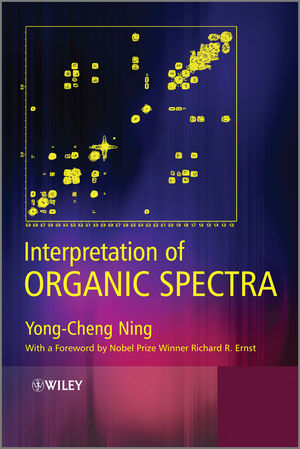Interpretation of Organic SpectraISBN: 978-0-470-82516-7
Hardcover
416 pages
March 2011
 |
||||||
Preface xi
1 Interpretation of 1H NMR spectra 1
1.1 Chemical shift 3
1.1.1 Conception of chemical shift 3
1.1.2 Factors affecting chemical shifts 3
1.2 Coupling constant J 7
1.2.1 Coupling effect and coupling constant J 7
1.2.2 Discussion of coupling constants according to their kinds 8
1.3 Chemical equivalence and magnetic equivalence 11
1.3.1 Chemical equivalence 13
1.3.2 Magnetic equivalence 17
1.3.3 Classification of 1H spectra 18
1.4 Characteristics of the 1H spectra of some functional groups 19
1.4.1 Substituted phenyl ring 19
1.4.2 Substituted heteroaromatic ring 21
1.4.3 Normal long-chain alkyl group 21
1.4.4 Carbonyl compounds 21
1.4.5 Reactive hydrogen atom 22
1.4.6 Compounds containing fluorine or phosphor atoms 23
1.5 Interpretation of 1H NMR spectra 23
1.5.1 Find impurity peaks, pay attention to the solvent applied 24
1.5.2 Calculation of the unsaturation number of the unknown compound 24
1.5.3 Determination of the number of hydrogen atoms corresponding to every peak set in the 1H spectrum 25
1.5.4 Determination of functional groups of the unknown compound 26
1.5.5 Analysis of coupling splittings of peak sets 26
1.5.6 Combination of possible structural units 27
1.5.7 Assignment of the 1H spectrum according to the deduced structure 28
1.5.8 Checking of the deduced structure 28
1.6 Examples of 1H spectrum interpretation 29
Reference 38
2 Interpretation of 13C NMR spectra 39
2.1 Characteristics and advantages of the 13C NMR spectra 39
2.2 The main parameter of the 13C spectrum is the chemical shift 41
2.3 Chemical shift values of common functional groups and main factors affecting chemical shift values 42
2.3.1 Alkanes and their derivatives 43
2.3.2 Cycloalkanes and their derivatives 45
2.3.3 Alkylenes and their derivatives 45
2.3.4 Benzene and its derivatives 46
2.3.5 Carbonyl groups 47
2.4 Determination of the carbon atom orders 47
2.5 Steps for 13C NMR spectrum interpretation 48
2.5.1 Recognizing impurity peaks and identifying solvent peaks 49
2.5.2 Calculation of the unsaturation number of the unknown compound 50
2.5.3 Consideration of chemical shift values of peaks 50
2.5.4 Determination of carbon atom orders 51
2.5.5 Postulation of possible functional groups 51
3 Interpretation of 2D NMR spectra 53
3.1 General knowledge about 2D NMR spectra 53
3.2 Homonuclear shift correlation spectroscopy, COSY (H, H-COSY) 54
3.3 Heteronuclear shift correlation spectroscopy 68
3.4 Long-range heteronuclear shift correlation spectroscopy 75
3.5 NOESY and ROESY 79
3.6 Total correlation spectroscopy, TOCSY 84
References 85
4 Interpretation of mass spectra 87
4.1 Basic knowledge of organic mass spectrometry 87
4.1.1 Mass spectra 87
4.1.2 Ionization in organic mass spectrometry 87
4.1.3 Ion types in organic mass spectrometry 88
4.2 Isotopic ion clusters in mass spectra 89
4.3 Interpretation of EI MS 91
4.3.1 Determination of molecular ion peak 91
4.3.2 Interpretation of fragment ion peaks 93
4.3.3 Interpretation of rearrangement ion peaks 98
4.3.4 Complex cleavages of alicyclic compounds 100
4.3.5 Mass spectrum patterns of common functional groups 102
4.3.6 Interpretation of the EI mass spectrum and examples 107
4.4 Interpretation of the mass spectra from soft ionization 115
4.4.1 Mass spectra from ESI (electrospray ionization) 115
4.4.2 Mass spectra from CI 117
4.4.3 Mass spectra from FAB 118
4.4.4 Mass spectra from MALDI 119
4.4.5 Mass spectra from APCI 120
4.4.6 Examples of the interpretation of mass spectra from soft ionization 120
4.5 Interpretation of high resolution mass spectra 123
4.6 Interpretation of mass spectra from tandem mass spectrometry 126
References 127
5 Interpretation of infrared spectra 129
5.1 Elementary knowledge of infrared spectroscopy 129
5.1.1 Infrared spectrum 129
5.1.2 Two regions of the infrared spectrum 130
5.2 Characteristic absorption frequencies of functional groups 130
5.2.1 Elemental equation of IR spectroscopy 130
5.2.2 Factors affecting absorption frequencies 130
5.2.3 Characteristic frequencies of common functional groups 132
5.3 Discussion on the IR spectrum according to regions 132
5.3.1 Functional group region 133
5.3.2 Fingerprint region 135
5.4 Interpretation of IR spectra according to regions 135
5.5 Interpretation of IR spectra 139
5.5.1 Key points for the interpretation of IR spectra 139
5.5.2 Steps for the interpretation of an IR spectrum 140
5.5.3 Searching standard IR spectra from IR spectrum collections or websites 140
5.5.4 Examples of interpreting IR spectra 141
6 Identification of unknown compounds or confirmation of structures through comprehensive interpretation of spectra 147
6.1 Commonly used method and steps 148
6.1.1 1H spectrum 148
6.1.2 13C spectrum 149
6.1.3 DEPT spectrum 149
6.1.4 COSY spectrum 149
6.1.5 HMQC (or HSQC) spectrum 150
6.1.6 HMBC spectrum 150
6.2 Examples for the deduction of the structure of an unknown compound or for the confirmation of an anticipated structure 150
Reference 408
List of abbreviations 409
Index 411



